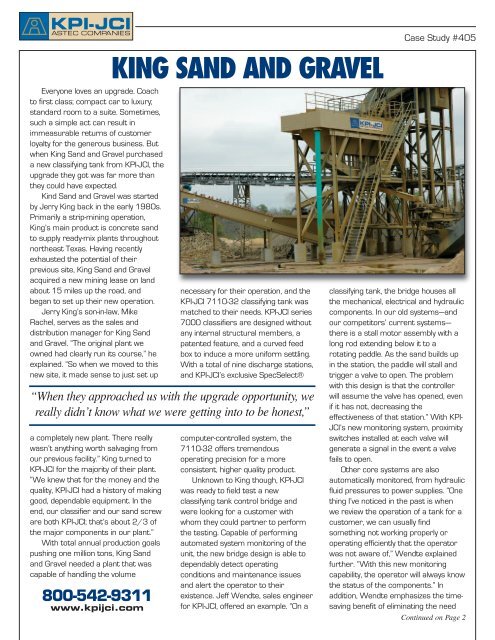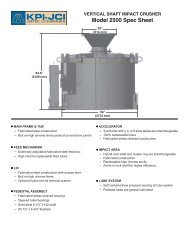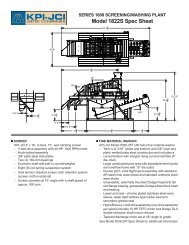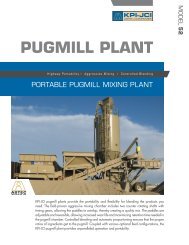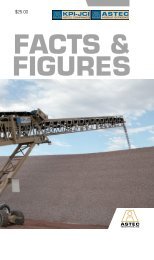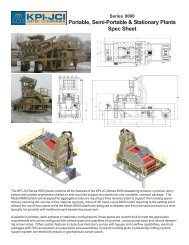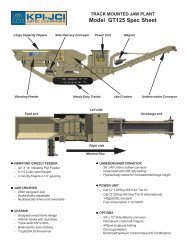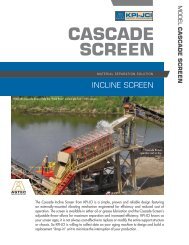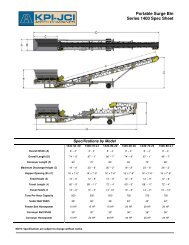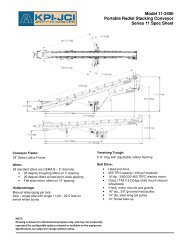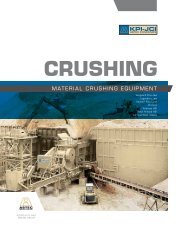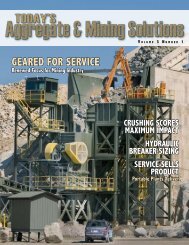KING SAND AND GRAVEL - KPI-JCI
KING SAND AND GRAVEL - KPI-JCI
KING SAND AND GRAVEL - KPI-JCI
Create successful ePaper yourself
Turn your PDF publications into a flip-book with our unique Google optimized e-Paper software.
Everyone loves an upgrade. Coachto first class; compact car to luxury;standard room to a suite. Sometimes,such a simple act can result inimmeasurable returns of customerloyalty for the generous business. Butwhen King Sand and Gravel purchaseda new classifying tank from <strong>KPI</strong>-<strong>JCI</strong>, theupgrade they got was far more thanthey could have expected.Kind Sand and Gravel was startedby Jerry King back in the early 1980s.Primarily a strip-mining operation,King’s main product is concrete sandto supply ready-mix plants throughoutnortheast Texas. Having recentlyexhausted the potential of theirprevious site, King Sand and Gravelacquired a new mining lease on landabout 15 miles up the road, andbegan to set up their new operation.Jerry King’s son-in-law, MikeRachel, serves as the sales anddistribution manager for King Sandand Gravel. “The original plant weowned had clearly run its course,” heexplained. “So when we moved to thisnew site, it made sense to just set upa completely new plant. There reallywasn’t anything worth salvaging fromour previous facility.” King turned to<strong>KPI</strong>-<strong>JCI</strong> for the majority of their plant.“We knew that for the money and thequality, <strong>KPI</strong>-<strong>JCI</strong> had a history of makinggood, dependable equipment. In theend, our classifier and our sand screware both <strong>KPI</strong>-<strong>JCI</strong>; that’s about 2/3 ofthe major components in our plant.”With total annual production goalspushing one million tons, King Sandand Gravel needed a plant that wascapable of handling the volume800-542-9311www.kpijci.com<strong>KING</strong> <strong>S<strong>AND</strong></strong> <strong>AND</strong> <strong>GRAVEL</strong>necessary for their operation, and the<strong>KPI</strong>-<strong>JCI</strong> 7110-32 classifying tank wasmatched to their needs. <strong>KPI</strong>-<strong>JCI</strong> series7000 classifiers are designed withoutany internal structural members, apatented feature, and a curved feedbox to induce a more uniform settling.With a total of nine discharge stations,and <strong>KPI</strong>-<strong>JCI</strong>’s exclusive SpecSelect®“When they approached us with the upgrade opportunity, wereally didn’t know what we were getting into to be honest,”computer-controlled system, the7110-32 offers tremendousoperating precision for a moreconsistent, higher quality product.Unknown to King though, <strong>KPI</strong>-<strong>JCI</strong>was ready to field test a newclassifying tank control bridge andwere looking for a customer withwhom they could partner to performthe testing. Capable of performingautomated system monitoring of theunit, the new bridge design is able todependably detect operatingconditions and maintenance issuesand alert the operator to theirexistence. Jeff Wendte, sales engineerfor <strong>KPI</strong>-<strong>JCI</strong>, offered an example. “On aCase Study #405classifying tank, the bridge houses allthe mechanical, electrical and hydrauliccomponents. In our old systems—andour competitors’ current systems—there is a stall motor assembly with along rod extending below it to arotating paddle. As the sand builds upin the station, the paddle will stall andtrigger a valve to open. The problemwith this design is that the controllerwill assume the valve has opened, evenif it has not, decreasing theeffectiveness of that station.” With <strong>KPI</strong>-<strong>JCI</strong>’s new monitoring system, proximityswitches installed at each valve willgenerate a signal in the event a valvefails to open.Other core systems are alsoautomatically monitored, from hydraulicfluid pressures to power supplies. “Onething I’ve noticed in the past is whenwe review the operation of a tank for acustomer, we can usually findsomething not working properly oroperating efficiently that the operatorwas not aware of,” Wendte explainedfurther. “With this new monitoringcapability, the operator will always knowthe status of the components.” Inaddition, Wendte emphasizes the timesavingbenefit of eliminating the needContinued on Page 2
for trial-and-error troubleshootingwhen an operator does identify thatsomething is not functioning properly.“A lot of valuable time can be wastedhunting for problems. This new systemcan troubleshoot automatically,allowing problems to be fixed quicklyand the unit to be back online sooner.”Ironically, the value of such asystem cannot be recognized until acomponent on the classifying tank fails,800-542-9311www.kpijci.comand <strong>KPI</strong>-<strong>JCI</strong> equipment is notknown for frequent failures.Still, two opportunities didarise since the system wasinstalled at the King Sand andGravel site for field testing.When the classifier was firstinstalled in the fall of 2005,the system detected ahydraulic leak, andappropriately shut down theunit. The leak was quickly fixedand the tank resumedoperation. About eight monthslater, a small power supplywas detected to have failed; ittoo was quickly replaced.While the issues were minor,the monitoring systemperformed as expected,notifying the operator of theissue appropriately.Another major changemade to the <strong>KPI</strong>-<strong>JCI</strong> classifyingtank was the transition fromAC coils to DC coils. Wendteexplained the benefits of thatchange. “AC coils are whatphysically energizes thecartridge valve for opening andclosing…but they are like lightbulbs—you can take two fromthe same package, and onemay blow in an hour while theother works perfectly for twoyears. They’re just inherentlyunreliable.” The more reliableDC coils blow much lessfrequently. “That tank hasn’t blown acoil yet. Normally, they would havereplaced a few AC coils by now,”Wendte added. The obvious advantageis the reduction in replacement partsand time; but less obvious is the gain inproductivity from not having valves fail.Because a failed valve decreases theproductivity and effectiveness of theclassifier, ensuring they are fullyfunctional at all times results in agreater volume of high-quality material.For Rachel and King Sand andGravel, their new <strong>KPI</strong>-<strong>JCI</strong> classifyingtank has far exceeded theirexpectations. “It has worked outexceptionally. When they approachedus with the upgrade opportunity, wereally didn’t know what we were gettinginto to be honest,” Rachel recalled.“None of us are very computer literate,but the transition for us to go to theautomated system was very easy.” Theresults for <strong>KPI</strong>-<strong>JCI</strong> have been verysatisfying as well. “The performance ofthis system in the field has definitelymet our goals,” Wendte said. “Withinthe next few months, we expect totransition all our tanks to DC coils, andthe new systems monitoring bridge willbe an available upgrade later this year.”As King Sand and Gravel settlesinto their new facility, the efficiency oftheir new classifier has been quitebeneficial to the operation. “Everythingthat comes out of the mine gets soldas something,” Rachel explained. “Theoversize we sell for fill and such—generally the largest stone we get is4–5”. The screen decks then separate1.5” minus stone, 3/8” minus peastone, before the sand slurry isdirected to the classifier. From there,King uses <strong>KPI</strong>-<strong>JCI</strong>’s SpecSelect systemto generate various mixes of concretesand, until the finest material comesthrough the bottom of the tank and issold as mortar sand. “It took sometime to get our programming set,” saidRachel. “But once we got all therecipes in the system that we needed,creating an accurate and consistentspec product is extremely easy.Because the material that comes outof the ground will always fluctuate,being able to quickly compensate forthat is a big plus.”With a dozen trucks on the roaddelivering material throughoutnortheast Texas, King Sand and Gravelis well-positioned to capitalize on theirnew mine and processing plant tomeet the aggregate demands of themarket more efficiently than ever. Andwhen future needs arise that requireadditional equipment investments tomeet them, Rachel said he mostdefinitely will turn to <strong>KPI</strong>-<strong>JCI</strong> again. “Thepeople at <strong>KPI</strong>-<strong>JCI</strong> have been easy to getalong with, the service is excellent andthe quality of the products has verymuch met our expectations. We’ll beturning to <strong>KPI</strong>-<strong>JCI</strong> again in the futurefor sure!”


